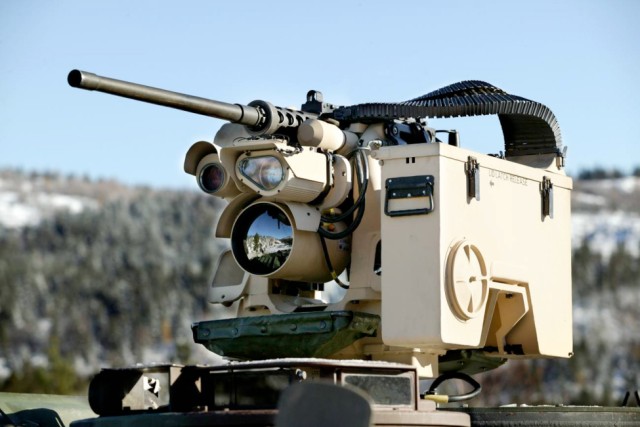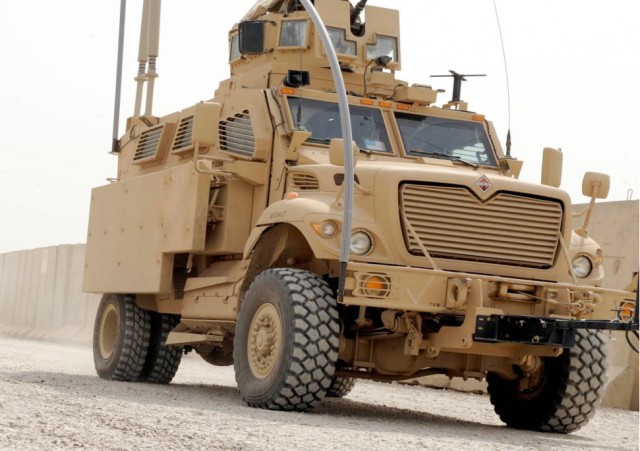Aberdeen Proving Ground, MD -- U.S. Army Materiel Command Commander Gen. Ann E. Dunwoody, U.S. Army Research, Development and Engineering Command Commander Maj. Gen. Paul S. Izzo, and other senior Army science and technology leaders will recognize the U.S. Army's "Top Ten Greatest Inventions of 2008" in an awards ceremony September 21 at the Hyatt Regency Crystal City, Arlington, Va.
The annual Army-wide awards program is dedicated to recognizing the best technology solutions for Soldiers. Nominations for the program were submitted from across the Army's science and technology community.
Soldiers from three active duty divisions selected ten winning programs based upon their inventiveness, their potential benefit outside the Army, and their impact on Army capabilities from the warfighter perspective.
This year the U.S. Army will recognize the following inventions that were fielded within the Army during 2008:
1. XM153 Common Remotely Operated Weapon Station (CROWS); U.S. Army Armament Research, Development and Engineering Center
Capable of being mounted on a variety of vehicles, this system provides the capability to remotely aim and fire a suite of crew-served weapons from either a stationary platform or while on the move, using the system power of the host vehicle. The system affords increased Soldier protection since the gunner is not exposed. It enhances target acquisition, identification, and engagement capabilities for non-turreted light armored vehicles; and also situational awareness during both day and night conditions using day and thermal cameras.
2. Projectile Detection Cueing (PDCue)- Common Remotely Operated Weapon Station (CROWS) Lightning; U.S. Army Armament Research, Development and Engineering Center
The Projectile Detection Cueing 4-Corner System is a low cost acoustic gunfire detection system capable of detecting and locating the origin of incoming gunfire events. The Common Remotely Operated Weapon Station Lightning is a lightweight common remotely operated weapon station capable of supporting small arms weapons. The fully integrated PDCue-CROWS Lightning system introduces new capabilities not present in their standalone configurations and provides quicker response and enhanced situational awareness for the operator. The operator can monitor, control, and command both PDCue and CROWS Lightning from a single user interface. The integrated system increases Soldier effectiveness in detecting and locating enemy sniper positions, and provides the Soldier the ability to automatically move remote weapon stations to the detected sniper threat.
3. Light Machine Gun & Medium Machine Gun Cradle; U.S. Army Armament Research, Development and Engineering Center
The Light Machine Gun & Medium Machine Gun Cradle addresses Soldier concerns about the lack of a location on the M197 Machine Gun Mount to reliably hold ammunition for the M249 light machine gun and the M240B medium machine gun. The cradle provides a more stable and more accurate firing platform and reliable, twist-free ammo feeding regardless of weapon orientation. It also includes a spent brass deflector and an integral quick-release travel lock that holds the machine guns steady during vehicle movement. The cradle eliminates the hazard of a full-length belt of ammo hanging loose from the weapon as well as machinegun stoppages due to twisted or snagged ammo by keeping ammo in-line with the feed tray.
4. Overhead Cover for Objective Gunner Protection Kit; U.S. Army Armament Research, Development and Engineering Center
The Overhead Cover is an integrated armor/ballistic glass system mounted onto the Objective Gunner Protection Kit of tactical and armored vehicles. It provides an enhanced 360 degree ballistic protection while retaining visibility for situational awareness by Gunners without compromising system effectiveness, reliability or lethality. The Overhead Cover offers ideal concealment, weapon maneuverability, and weight while providing protection against hand grenades, rocks, incendiaries, and liquids such as bleach and acid that have been thrown onto turret gunners.
5. Enhanced Mobile Rapid Aerostat Initial Deployment Vehicle; U.S. Army Aviation and Missile Research, Development, and Engineering Center
The Enhanced Mobile Rapid Aerostat Initial Deployment Vehicle system combines multiple intelligence, surveillance, and reconnaissance capabilities onto a single, integrated platform. This configuration enables users to rapidly deploy the system anywhere a mission requires additional intelligence, surveillance, and reconnaissance capabilities. Forward operating bases often receive direct and indirect fire on a daily basis and the lack of these capabilities at remote sites place additional risks on Soldiers. The system gives remote operating units the ability to quickly employ the system's combined capabilities to detect imminent attacks and take the appropriate actions to defeat enemy forces.
6. Whisper; U.S. Army Communications-Electronics Research, Development and Engineering Center
The Whisper system, a passive detection capability, has been integrated into the engineer's reconnaissance vehicle used by combat engineer companies. The system features advanced electronic warfare equipment to detect critical radio controlled improvised explosive device threats used by the enemy. An optimized architecture is used to maximize system performance, interoperability, and compatibility while minimizing the overall system cost and prime power consumption requirements. The system's design supports future enhancements with minimal hardware redesign through adaptable software and hardware system components.
7. Combat Gauze for Treating Hemorrhage in Injured Soldiers; U.S. Army Institute of Surgical Research
Hemorrhage accounts for 50 percent of the deaths among combat casualties and a high percentage of these deaths are potentially preventable with prompt and effective treatment of hemorrhage. The development of combat gauze offers the medic a simple, cost-effective hemostatic product to treat severe external bleeding, especially in areas where a tourniquet cannot be applied. It is a large-sized flexible roll of non-woven medical gauze impregnated with a contact pathway activating clotting agent known as kaolin. The dressing can be used on surface wounds and has been proposed to treat deep bleeding at the end of a long wound tract.
8. Mine-Resistant Ambush-Protected Armor Weight Reduction Spiral Program; U.S. Army Research Laboratory
The Mine-Resistant Ambush-Protected Armor Weight Reduction Spiral Program enabled the Army to directly meet MRAP program protection requirements for a high priority, anti-armor, improvised explosive device threat. The program's technical approach combined cutting-edge high-performance computing with highly instrumented terminal effects experimentation to exploit known heavy technologies used to defeat low-level, improvised explosive device threats to understand the most viable armor mechanisms for efficient penetrator defeat. The program's goal was to introduce lightweight composites, new materials, and enhanced ballistic mechanisms to reduce the add-on weight of final armor packages. The resulting composites were applied to individual platforms to maximize the vehicle and increase Soldier survivability.
9. Mine Resistant Ambush Protected Expedient Armor Program Add-on-Armor Kit; U.S. Army Tank Automotive Research, Development and Engineering Center
The Expedient Armor Program Add-on-Armor Kit for Mine Resistant Ambush Protected vehicles was developed to safeguard Soldiers against the extremely lethal threats of improvised explosive devices and explosively formed penetrators. The armor uses armor physics, as opposed to armor mass, to defeat the threat, which led to a 50 percent reduction in weight, while greatly increasing the armor protection on all MRAP vehicles without sacrificing vehicle performance or payload.
10. One System Remote Video Terminal A-kit; U.S. Army Tank Automotive Research, Development and Engineering Center
The One System Remote Video Terminal A-kit is an innovative modular video and data system that enables Soldiers to remotely receive near-real-time surveillance image and geospatial data directly from tactical unmanned aerial vehicles and manned platforms. The kit was designed to immediately address a gap between the product and the emerging need in theater today. It allows Soldiers to egress vehicles faster and more safely in case of an emergency and also enhances situational awareness with unmanned aerial vehicle surveillance for mission planning, intelligence gathering, and monitoring of enemy activity, resulting in greater Soldier safety and survivability.
For more information contact the RDECOM Public Affairs Officer, Robert DiMichele, at 410-436-4345.






Social Sharing